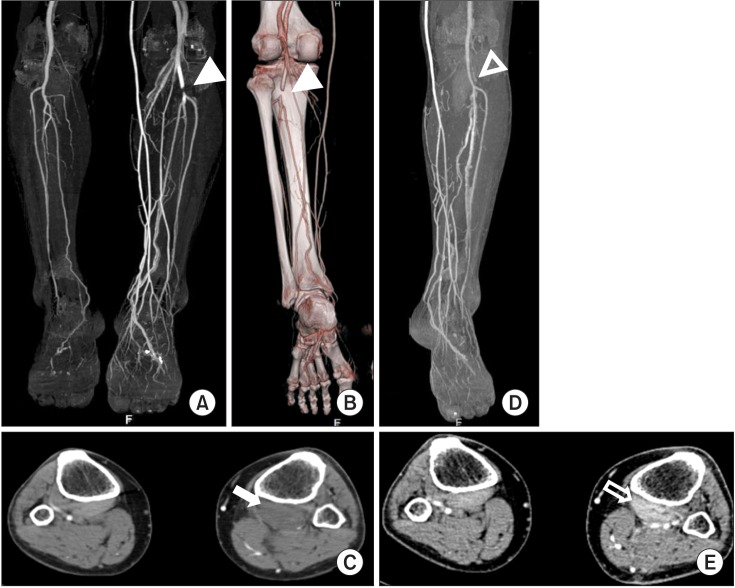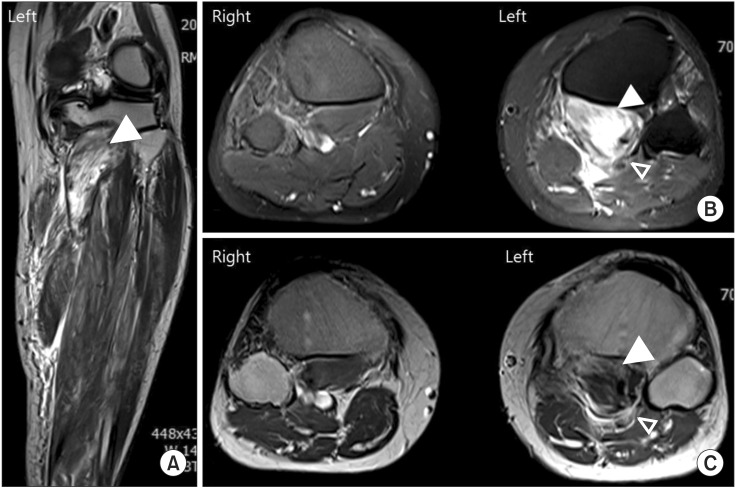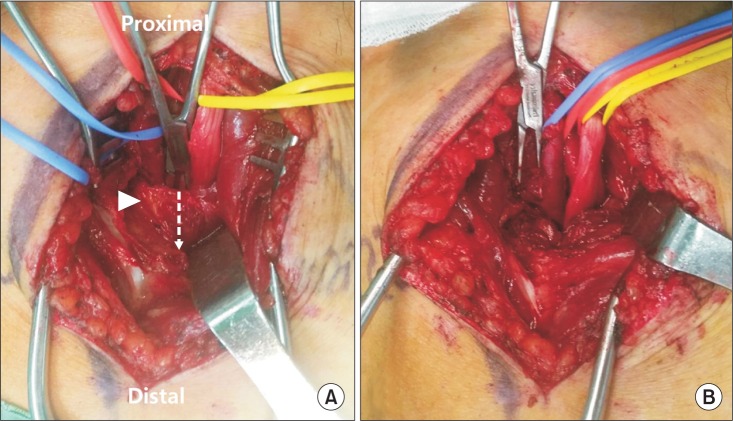Ann Rehabil Med.
2016 Jun;40(3):545-550. 10.5535/arm.2016.40.3.545.
Neurovascular Compression Caused by Popliteus Muscle Enlargement Without Discrete Trauma
- Affiliations
-
- 1Department of Physical Medicine and Rehabilitation, Sun General Hospital, Daejeon, Korea. nkpark@sunhospital.co.kr
- 2Department of Vascular Surgery, Sun General Hospital, Daejeon, Korea.
- KMID: 2327619
- DOI: http://doi.org/10.5535/arm.2016.40.3.545
Abstract
- Popliteal entrapment syndrome caused by isolated popliteus muscle enlargement is very rare, although its occurrence has been reported after discrete trauma. However, popliteal artery stenosis with combined peroneal and proximal tibial neuropathy caused by popliteus muscle enlargement without preceding trauma has not been reported. A 57-year-old man presented with a tingling sensation and pain in his left calf. He had no previous history of an injury. The symptoms were similar to those of lumbosacral radiculopathy. Calf pain became worse despite treatment, and the inability to flex his toes progressed. Computed tomography angiography and magnetic resonance imaging of the lower extremity showed popliteal artery stenosis caused by popliteus muscle enlargement and surrounding edema. An electrodiagnostic study confirmed combined peroneal and proximal tibial neuropathy at the popliteal fossa. Urgent surgical decompression was performed because of the progressive neurologic deficit and increasing neuropathic pain. The calf pain disappeared immediately after surgery, and he was discharged after the neurologic functions improved.
Keyword
MeSH Terms
Figure
Reference
-
1. Kim S, Choi JY, Huh YM, Song HT, Lee SA, Kim SM, et al. Role of magnetic resonance imaging in entrapment and compressive neuropathy - what, where, and how to see the peripheral nerves on the musculoskeletal magnetic resonance image: part 1. Overview and lower extremity. Eur Radiol. 2007; 17:139–149. PMID: 16572334.2. Geissler WB, Corso SR, Caspari RB. Isolated rupture of the popliteus with posterior tibial nerve palsy. J Bone Joint Surg Br. 1992; 74:811–813. PMID: 1447239.
Article3. Bowditch MG, Kay NR. Painful swollen calf due to isolated rupture of popliteus. Injury. 1994; 25:200–201. PMID: 8168898.
Article4. de Ruiter GC, Torchia ME, Amrami KK, Spinner RJ. Neurovascular compression following isolated popliteus muscle rupture: a case report. J Surg Orthop Adv. 2005; 14:129–132. PMID: 16216180.5. Bollier M, Ream T, Hodgman G. Isolated popliteus muscle rupture with neurovascular compression requiring surgical decompression. Am J Orthop (Belle Mead NJ). 2010; 39:588–591. PMID: 21720576.6. Dimberg EL, Rubin DI, Ortiguera CJ, Kennelly KD. Popliteus muscle hemorrhage as a rare cause of a proximal tibial neuropathy. J Clin Neurosci. 2014; 21:520–521. PMID: 24120709.
Article7. Ortiguera CJ, Bremner BR, Peterson JJ. Popliteus strain causing tibial nerve palsy with a permanent partial deficit: a case report. Am J Sports Med. 2006; 34:1176–1180. PMID: 16452266.8. Jadhav SP, More SR, Riascos RF, Lemos DF, Swischuk LE. Comprehensive review of the anatomy, function, and imaging of the popliteus and associated pathologic conditions. Radiographics. 2014; 34:496–513. PMID: 24617694.
Article9. Park KS, Lee MG. Effects of unaccustomed downhill running on muscle damage, oxidative stress, and leukocyte apoptosis. J Exerc Nutrition Biochem. 2015; 19:55–63.
Article
- Full Text Links
- Actions
-
Cited
- CITED
-
- Close
- Share
- Similar articles
-
- Glossopharyngeal Neuralgia with Syncope Caused by Neurovascular Compression and Demonstration by High-Resolution MR Imaging: A Case Report
- Neurovascular Compression Syndrome of the Eighth Cranial Nerve
- MRI Findings of Accessory Popliteus Muscle: A Case Report
- Microvascular triple decompression for combined simultaneous trigeminal neuralgia, hemifacial spasm, and pulsatile tinnitus due to separate offending vessels
- Shape and innervation of popliteus muscle




